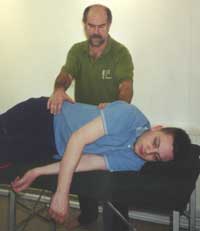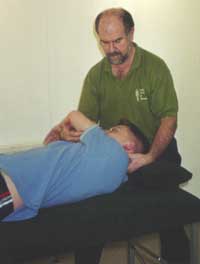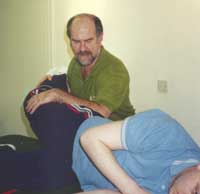Positive Health Online
Your Country

Rhythm Mobility
by Darien Pritchard(more info)
listed in massage, originally published in issue 63 - April 2001
Most massage practitioners have had the experience of massaging a client who seems to be 'stuck' in his tension and wants the masseur to work more deeply; but the firmer the massage the more he seems to 'resist', and it feels more like he needs 'a good shaking up'. Or the experience of wondering how to coach a client into 'giving over' her arm when you're trying to massage it – she won't 'let it go' for you to move it. Or of giving a massage to a client who says he's stressed and wants to be more relaxed, but who seems more in need of a boost of energy to deal with the challenges of his life.
Over the years, as I've tried to make my work more effective in response to these and similar challenges, and easier for myself, the twin qualities of rhythm and movement have come to the fore. Attempting to 'force' clients to release long-term tensions merely by increasing the power of application beyond a comfortable point ('pummelling them into submission') is, in fact, counter-productive. Instead, gentle vibration and rhythmical movement present a means of circumventing rather than provoking the automatic (unconscious) protective response of tensing when the body feels 'attacked'.[1]
RhythmMobility Techniques
When shaped by the essential massage qualities of pacing, fluidity, continuity, and monitoring and adapting to the client's responses, these techniques can complement and extend the release engendered by 'classic' massage techniques such as stroking, kneading, pressure and friction. They can be used to 'flavour' those classic strokes, to extend passive movements (a growing part of the massage repertoire) or as 'pure' techniques on their own.

Gentle vibration to open the side of the ribs
RhythmMobility techniques are used to energize the client and encourage release of deep tensions simultaneously. They include muscle shaking and vibration, the 'shudder', push/pull, joint releases, rhythmical stretches, body rocking and combination strokes (such as maintaining rhythmic rocking of the body while simultaneously shaking out muscles or rhythmically applying deep pressure to areas of tension). The effect can be primarily relaxing, stimulating or both. In addition, this approach can engender a sense of interconnection throughout the body, and help the client to rediscover forgotten possibilities of movement.
As with massage, the focus of a session can be on a general release of tension throughout the body, or to address particular problem areas or movement restrictions. Massage, as well as releasing physical tensions, is often used to address a client's need for friendly nurturing touch; RhythmMobility also speaks to another basic need that is often restricted in adult life – the need to move and be moved, as children are in games and on playground equipment.
Massage, Movement and Rhythm
In my early years as a massage practitioner, I learned to emphasize the 'rhythmical', potentially more energizing strokes of massage (percussion and vibration) with clients who intended to return to work after the treatment, and therefore wanted to leave my studio unstressed but also alert. This led me to experiment with various massage machines such as hand-held vibrators and vibrating cushions. I liked their general effect but soon found that I could be much more specific and adaptable to my clients' needs and responses than a machine in applying 'shudders' through the muscles.
| Percussion and Vibration Techniques Percussion techniques are the ‘drumming’ strokes of massage – e.g. tapping with the fingertips, clapping with the front of the hand, pounding with the side of a soft fist. Vibration refers to shaking, rhythmical strokes where there is continuous hand contact – e.g. shaking tissue from side to side (a ‘jelly-wobble’ effect), or shaking out a limb. |
Creative dance and t'ai chi classes fed into my developing sense of pace, rhythm, movement and continuity. And then a colleague who was a shiatsu practitioner gave me the key to pull all of these elements together – she taught me some body rocking, to which my clients responded with enthusiasm. I was inspired to add rhythmical elements to yoga stretches that I'd learnt to use with clients, and later to most massage strokes.
So for a long time my rhythmical work was very much an aspect of massage, added in to the 'classic' strokes. It made my work easier – for both the client to receive, and for me, the practitioner, to give. And the older I get, the more important the ease of working has become.

Releasing neck and shoulder
When used sensitively and with patience, this gentle addition of movement and vibration offers a way to 'get round' many clients' ingrained defences.[2] It feels almost like 'tricking' them into letting go.
Gradually it was borne in on me by the responses of clients and colleagues that this could also be a whole approach in itself, using massage sensibilities to encompass much of the range of qualities that are essential to good massage – such as 'flow' and continuity, an awareness of pacing, sequence and integration, gauging the appropriate use of pressure, a knowledge of anatomy, and an understanding of muscles and tension.
The movement repertoire and perceptions that I bring to bear was greatly expanded by Feldenkrais training in the 1980s, and this also gave me a perspective on bodywork directed towards rebalancing the use and tone of musculature throughout the body.[3-5] My work has been further enriched in recent years by exposure to Trager work6 and training in pulsing, the Trager offshoot developed by two British psychotherapists to encourage emotional release.
As in massage, RhythmMobility can be varied from the sedating to the invigorating, from the gentle to the vigorous, from the quiet to the boisterous, from soft nurturing touch on the skin to deeper work on specific tensions and problem areas. The difference is that after a good massage one can feel absolutely 'zonked'; a good RhythmMobility session leaves one with an inner 'buzz' – relaxed but also gently invigorated.
People remain clothed in these sessions, but are asked to remove jewellery, glasses, belts and shoes. RhythmMobility work is generally done on a massage table – with the client lying face up, face down, or on their side – but can be applied to a seated client. What happens in the session will be shaped by the person's build and tensions, their expressed needs and responses.

Releasing the lower back and hips
Training in RhythmMobility
To further illustrate the scope of this approach, I'll describe some of the considerations in training practitioners. I had always included elements in massage training courses, but presenting it as separate advanced training in recent years made me clarify the necessary ingredients and the specific skills and perceptions that students need to master.
Like any bodywork method, it can easily be done badly – to the detriment of both the practitioner (straining the body) and the recipient (bruising or worse). Therefore it's only taught as advanced training for massage practitioners, who have the necessary background skills and attitudes that are essential to using it well. Skilled masseurs have practice in monitoring and adapting techniques to the client's build, tensions and responses, and an understanding in practical terms of the importance of co-ordination, continuity and pacing. They also have the ability to 'translate' from their previous massage experience into these new handling skills, and can quickly learn to blend this way of working smoothly into a massage session.
Training is initially focused on the types of techniques that can be used throughout the body, and the qualities of touch that need to be developed. An important starting point is learning to search out 'natural' body rhythms and resiliences in response to oscillating movements – on each client, and each area of their bodies. This is the same process as discovering how to push a child on a swing – what force gives maximum effect and minimum disruption (which, of course, varies from child to child and can change if the child sits differently, or you stand at a different angle to push), and at what point in the movement to apply the push and how (i.e. not too suddenly or jerkily). When the work is very gentle, it is more like following the quiet lapping of water at the sea's edge on a calm day.
|
Cautions and Contraindications Cautions Contraindications |
It can be difficult to develop a feel for this, as there is no single rhythm that fits everyone. Each body has its own rhythms ('every-body got rhythm'), and so does each body part or area, due to the individual structure of each person, the distribution of their weight and their build. This can only be approached with an exploratory attitude, feeling your way until you find the easiest way of doing it – which signifies that this is the easiest movement for the client's body to respond to, as well as the easiest for the practitioner to do.
Appropriate body use by the practitioner, an area of growing importance for massage teachers and practitioners,7 is taught as an integral aspect of working, so that the techniques are comfortable and effective for both giver and receiver. There is particular emphasis on reducing the workload and consequent strain on hands, wrists and fingers, a developing concern in the world of massage.[4] This is addressed by emphasis on using the whole body to gain power behind the techniques, and considerable use of the forearm, and even elbow, where appropriate. The RhythmMobility worker is encouraged to 'dance' their invitation, coaxing the recipient to enter into responsive oscillations, like the 'dance' of moored boats in lapping water.
As in massage, there is a world of difference between merely imposing a set of routine techniques on the client and actually discovering what fits him/her. RhythmMobility training teaches the practicalities of finding techniques that are pleasant and comfortable for each individual client. This is interwoven with a search to discover the level of operating that 'speaks' to the recipient (so that they feel that you are 'engaging' with their tissues – not too light and unconnecting, leaving them feeling untouched, nor too sudden, heavy or pushy, making them feel brutalized).
When the practitioner is comfortable with this process, and can find the easy 'meeting place' anywhere in the client's body, creating a sense of ease and trust, he/she is ready to learn how to extend the possibilities inherent in the movement. This is done initially by introducing easily manageable challenges for the client, and, if appropriate, more testing ones. Specific skills are learnt to encourage and amplify movements. Further practical instruction covers the establishment of related overriding rhythms, movements that incorporate other or extra directions/ dimensions, or complementary counter-rhythms in other body parts.
These techniques are usually more testing for the practitioner too, needing a refinement of physical handling skills (e.g. maintaining a rocking rhythm throughout the client's body, while initiating a smaller rhythmical movement or pressure in one particular area). Composite movements can be hard to learn – like a musician's early struggles to master co-ordinated but different hand movements necessary to playing an instrument – but are worth perseverance because of the deep release they can promote.
Students are also trained in both specific applications and general strategies to use for problem areas – areas of chronic stiffness, pain or lack of mobility – and how to 'work around' them, if necessary, in order to minimize their interference with the overall sense of the moving, vibrating body.
In all of my teaching, two overall attitudes are encouraged in the practitioner, and hopefully therefore communicated to the client. The first is 'pleasure seeking' – to give a client, even with severe restrictions, the enjoyment of the movement range that they do have, rather than a disapproving attitude of constantly pushing at the limits of their comfortable range – causing pain, emphasizing restrictions, and thus often reinforcing a negative and sometimes disabling self-image.
I also want the practitioner to cultivate an attitude of curiosity in their work. Bodywork should not be applied as an undeviating routine for everybody, but as a search to find out about the particular client at that moment (e.g. about how this person is able to respond to particular invitations; their flexibilities and restrictions; and how to tease/coax/coach more suppleness and mobility).
Summary
So this article is intended to give a flavour of an approach that overlaps with and extends the scope of massage – to release muscle tension, and help increase joint mobility, and encourage suppleness and energy throughout the body.
I am not the only person exploring this territory, but I do have a background in massage and Feldenkrais that shapes the sensibilities that I bring to it. And the evolution of my approach has been fed by an active interest in singing, dancing, playing music and drumming.
I see it as a part of the rich weave of developments that are extending the field of bodywork. This one specifically addresses the natural human inclination towards movement and rhythm – expressed throughout human history by dance and music making, but now sadly being diminished through extended sedentary working environments and lifestyles.
References
1. Cash M. Sports and Remedial Massage Therapy. Ebury Press. London. p48. 1996.
2. Sanderson Mary. Soft Tissue Release. Corpus Publishing, Chichester. p8. 1998.
3. Feldenkrais Moshe. Body and Mature Behaviour. Routledge and Kegan Paul. London. 1949. International Universities Press. New York. 1970.
4. Feldenkrais Moshe. The Elusive Obvious. Meta Publications. California. 1981.
5. Alon Ruthy. Mindful Spontaneity. North Atlantic Books. California. 1996.
6. Trager Milton. Trager Mentastics®. Station Hill Press. New York. 1987.
7. Fagg Andy and Pritchard Darien. Dynamic Bodyuse in Massage. Positive Health. 40. May 1999.
Further Reading
Greene Lauriann. Save Your Hands. Infinity Press. Seattle. USA. 1995.
Pyves Gerry. No Hands Massage. Shi'Zen Publications. Huddersfield. 2000.
Tappan Frances. Healing Massage Techniques – A Study of Eastern and Western Methods. Reston Publishing. Virginia. USA. 1980.
Comments:
-
No Article Comments available